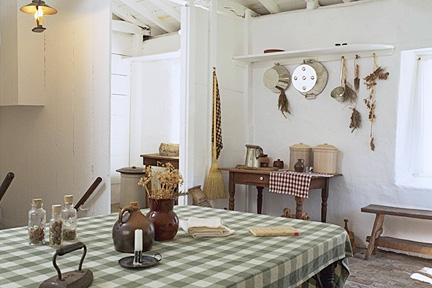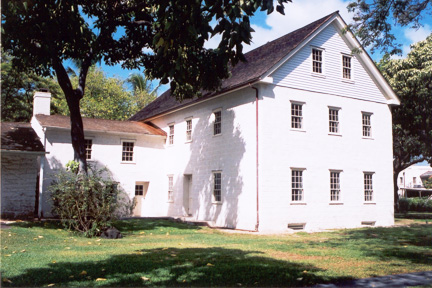
|
Hawaii’s
Back Yard |
Mission Museum is
a lesson in tenacity
Faith strong enough to move mountains compelled two ministers, two teachers, a doctor, a farmer, a printer and their families to journey from their home in Boston to remote Pacific islands to establish a Christian mission.
If you go ...What: Mission Houses MuseumAddress: 553 S. King St., Honolulu Hours: 10 a.m. to 4 p.m. Tuesdays through Saturdays. Guided tours are offered at 11 a.m. and 1 and 2:45 p.m. Admission: $10 general, $8 for kamaaina and $6 for students Call: 531-0481 E-mail: info@missionhouses.org Web site: www.missionhouses.org
|
When Thaddeus finally dropped anchor in Honolulu in April 1820, the New Englanders were thankful not only for their safe passage, but for their propitious timing. King Kamehameha I had died a year earlier, and his eldest son and successor, Liholiho (Kamehameha II), had abolished the kapu system, including worship of the ancient gods.
Samuel Ruggles, a member of the First Company, noted in his journal that the Hawaiian people "seem to be waiting for the law of Christ."
Scores of Hawaiians converted to the new religion, no doubt influenced by the support of Queen Kaahumanu, a favorite wife of Kamehameha I. Eager to learn everything she could about the Westerners' way of life, the queen was a frequent visitor to the Sandwich Islands Mission's headquarters in Honolulu.
The missionaries, in turn, learned about the Hawaiians' customs, foods and language, which until that point had been entirely oral. To spread the gospel, the missionaries realized they had to translate Hawaiian into written form, then teach people how to read.
Within a few years, the missionaries were printing scriptures, hymnals and spelling primers on an old iron-and-mahogany Ramage press they had brought with them around the Horn. The first Hawaiian edition of the Bible, which ran 2,331 pages, appeared in 1838.
It seemed the missionaries couldn't produce reading material fast enough; the Hawaiians came to the mission complex in droves, bringing arrowroot, taro, bananas, coconuts, sugar cane and fish to barter for precious pages off the press. Some even paid for books with labor.
The Sandwich Islands Mission flourished -- so much so that in 1863 the American Board of Commissioners for Foreign Missions deemed it no longer was necessary to keep it open.

Descendants of Hawaii's first missionaries established Mission Houses Museum in 1920, outfitting it with period housewares and artifacts.
The society's 1914 annual report observed: "Some families sent in one lone treasure, very precious, and from others came many relics, but when all were brought together in their original environment, the effect was wonderful. Visitors passed slowly through the rooms, listening to stories that clung to each article displayed, and especially were the descendants of the missionaries carried back through many years to the time of their grandparents."
Impressed by the response, Territorial Gov. George Carter proposed that a permanent museum be established on the site. Mission Houses Museum opened in 1920, the centennial of the establishment of the Sandwich Islands Mission.
To date, missionary descendants and other benefactors have donated more than 3,500 items to the museum, including dainty needlework, surgical implements, wooden and porcelain dolls, sewing boxes, quilts, clothing, furniture, photographs and china. It was designated a National Historic Landmark in 1962.
Only three of the original mission structures remain. One, constructed in 1841, has been transformed into a printing office housing a replica of the old Ramage press, a safe for storing paper, and a wood-and-metal cabinet with trays containing old type for printing.
The adjacent Chamberlain House was built in 1831 to be the home of the mission's business agent Levi Chamberlain. His family lived on the ground floor, and the top two levels were used to store goods and supplies. A special exhibition, "Defining Home: Mission Era Furniture of Hawaii," is on view in the house (see sidebar).
Pre-cut in Boston, the Frame House was built in 1821 and is the oldest wood-frame building in Hawaii. Visitors may peek into the parlor, bedrooms, dining room, kitchen, infirmary and children's dormitory while admiring original period pieces such as chests, four-poster koa beds, food safes, dishes and large chunks of limestone, through which brackish water collected from outside cisterns was filtered.

The Mission Houses Museum has had a few facelifts in its 85-year history, but its mission of preserving key elements of the islands' history remains the same.

How missionaries defined homeAlthough the missionaries were not trained as woodworkers, they believed that basic comforts such as furniture were essential to making a home for themselves in Hawaii."Defining Home: Mission Era Furniture of Hawaii," an exhibit of handcrafted Hawaiian furniture and furnishings made primarily of koa wood, will be on display in the Chamberlain House's First Floor Gallery of Mission Houses Museum through Aug. 20. Most of the pieces are from the early to mid-1800s and are among the oldest examples of furniture brought to or made in Hawaii. Admission is $5. Special events, including lectures by local artisans and an artist-in-residency program, will complement the exhibit. Call the museum for details.
Keepers of historyTwo important historical resources are located on the grounds of Mission Houses Museum: the Hawaiian Mission Children's Society Library and the Hawaiian Historical Society.The library, founded in 1822, safeguards several thousand rare books and materials focused on the 19th-century mission period of Hawaii and the Pacific. The comprehensive collection includes early printed material in the Hawaiian language; missionary letters and journals; reports from mission stations, churches and schools islandwide; and sketches, maps, photographs and artwork. The library shares a reading room with the HHS, which was founded in 1892. The society's collection of more than 12,000 books and pamphlets also covers Hawaiian and Pacific history, but from a more general perspective. Both libraries are open 10 a.m. to 4 p.m. Tuesdays through Fridays. For more information about the HMCS Library, call the museum. To learn more about the HHS Library, call 537-6271.
|
A decade passed before Bingham could accommodate Kaahumanu's request. She treasured the chair so much that it went wherever she did, even on trips to the other islands.
"As a staff, when we talk about the Kaahumanu rocker, we talk about what it represents in a metaphorical sense," says Marilyn Reppun, Mission Houses Museum's acting executive director. "In the eyes of the Hawaiians, Kaahumanu had great mana (divine power), but in 1825 she was baptized at Kawaiaha'o Church, a thatched structure at the time, and she promoted Christian teachings. She was a bridge connecting two very rich but different cultures."
Reppun joined Mission Houses Museum in 1991 as the head librarian for the Hawaiian Mission Children's Society Library (see sidebar). "I didn't know a lot about the history of the American Protestant mission prior to coming to the museum," she admits. "The person who oriented me, Lela Goodell, had been the assistant librarian for more than 26 years, and she came out of retirement to teach me.
"She would say to me every day, 'Stay in the vault and learn the collections.' So that's exactly what I did. I sat on a footstool in the chilly vault among the various books and manuscripts and read for several hours each day."
From missionary diaries, letters and other accounts emerged moving stories of hardship, joy, sorrow, hope and unwavering faith. As Reppun's knowledge about the missionaries grew, so did her respect for them.
"What is intriguing about the pioneer company of missionary men and women," she says, "is their tenacity and willingness, despite the potential for tremendous risk, to commit their lives to a mission which at the outset could not guarantee safety nor success to its members.
"Mission Houses Museum stands today as a testament to this stalwart, courageous group of people who very much shaped the course of Hawaii's history."
www.hawaiianhistory.org
[News] [Business] [Features] [Sports] [Editorial] [Do It Electric!]
[Classified Ads] [Search] [Subscribe] [Info] [Letter to Editor]
[Feedback]
